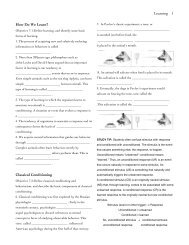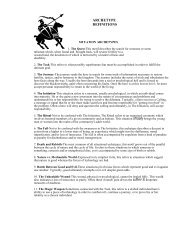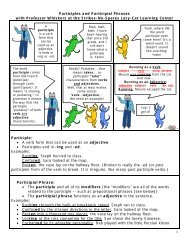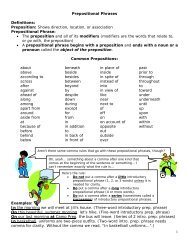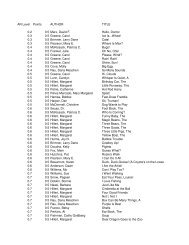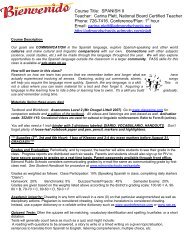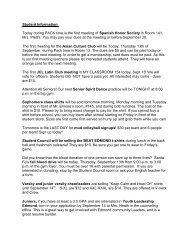PICTURE THIS! - Edmond Public Schools
PICTURE THIS! - Edmond Public Schools
PICTURE THIS! - Edmond Public Schools
You also want an ePaper? Increase the reach of your titles
YUMPU automatically turns print PDFs into web optimized ePapers that Google loves.
1<br />
<strong>PICTURE</strong> <strong>THIS</strong>!<br />
Murray, H. A. (1938). Explorations in personality (pp. 531-545). New York: Oxford University Press.<br />
In the previous reading, a method clinical psychologists use to expose underlying aspects of personality, called<br />
the projective test was discussed in relation to Rorschach's inkblot technique. The idea behind Rorschach's test was<br />
to allow individuals to place or project their own interpretations onto objectively meaningless and unstructured<br />
forms. Also, Rorschach examined a subject's focus on particular sections in the inkblot, the various specific<br />
features of that section, and perceptions of movement in the figure, to draw conclusions about the subject's<br />
personality characteristics. The content of the subject's interpretation was also taken into account, but was of<br />
secondary importance.<br />
Several years after Rorschach developed his test, Henry A. Murray (1893-1988), at the Harvard<br />
Psychological Clinic, and his assistant, Christiana D. Morgan, developed a very different form of a projective test<br />
called the Thematic Apperception Test, or TAT, which focused entirely on the content of the subjects'<br />
interpretations. Rather than formless shapes like Rorschach's inkblots, the TAT consists of black-and-white<br />
drawings depicting people in various ambiguous situations. The client or subject is asked to make up a story<br />
about the drawing. The stories are then analyzed by the therapist or researcher to reveal hidden unconscious<br />
conflicts (apperception means conscious perception).<br />
The theory behind the TAT was that when you observe human behavior, either in a picture or in real<br />
life, you will interpret that behavior according to the clues that are available in the situation. When the causes for<br />
the observed behavior are clear, your interpretation will not only be correct, it will be in substantial agreement<br />
with other observers. However, if the situation is vague and it is difficult to find reasons for the behavior, your<br />
interpretation will more likely reflect something about yourself—about your own fears, desires, conflicts, and so<br />
on. For example, imagine you see the faces of a man and a woman looking up into the sky with different<br />
expressions on their faces: He looks terrified, but she is laughing. As you observe the situation further, you see<br />
that they are waiting in line for a ride on "Batman," North America's highest mega-roller coaster located at Magic<br />
Mountain theme park in California. It is not difficult to interpret the couple's behavior in this situation and your<br />
analysis would probably be more or less the same as that of other observers. Now imagine seeing the same<br />
expressions in isolation, without any situational clues to explain the behavior. If you were asked, "What are these<br />
people experiencing?" your answer would depend on your internal interpretation and might reveal more about<br />
you than about the people you are observing. Furthermore, because of the ambiguity of the isolated behavior,<br />
different observers' answers would vary greatly (i.e., they're looking at a UFO, a ski run, small children playing<br />
on a high climbing toy, or an approaching tornado). This is the idea behind Morgan and Murray's Thematic<br />
Apperception Test, which to this day is a very popular tool among psychotherapists for helping their clients.<br />
THEORETICAL PROPOSITIONS<br />
At the most basic level, the theory underlying the TAT, like that of the Rorschach test, is that people's behavior<br />
is driven by unconscious forces. Implicit in this notion is an acceptance of the principles of psychodynamic<br />
psychology developed originally by Freud. In this view, unconscious conflicts must be exposed for accurate<br />
diagnosis and successful treatment of psychological problems to take place. This was the purpose of Rorschach's<br />
inkblot test, discussed in the previous reading, and it was also the goal of Murray's TAT.<br />
Morgan and Murray wrote, "The purpose of this procedure is to stimulate literary creativity and thereby<br />
evoke fantasies that reveal covert and unconscious complexes" (p. 530). The way they conceived of this process<br />
was that a person would be shown ambiguous drawings of human behavior. In trying to explain the situation, the<br />
subject would become less self-conscious and less concerned about being observed by the therapist. This would,<br />
in turn, cause the person to become less defensive and reveal inner wishes, fears, and past experiences that might<br />
have been repressed. Murray also pointed out that part of the theoretical foundation for this test was that "a<br />
great deal of written fiction is the conscious or unconscious expression of the author's experiences or fantasies"<br />
(p. 531).<br />
METHOD<br />
In the test's original conceptualization, subjects were asked to guess the events leading up to the scene depicted<br />
in the drawing and what they thought the outcome of the scene would be. After testing the method, it was<br />
determined that a great deal more about the psychology of subjects could be obtained if they were simply asked<br />
to make up a story about the picture, father than asked to guess the facts surrounding it.
2<br />
The pictures themselves were developed to stimulate fantasies in the subjects about conflicts and<br />
important events in their own experiences. Therefore, it was decided that each picture should involve at least one<br />
person with whom the subject could easily identify. Through trial and error with several hundred pictures, a final<br />
set of 20 was chosen. Since the TAT is in common use today, many believe that widespread publication of the<br />
pictures used might compromise its validity. However, it is difficult to understand the test without being able to<br />
see the type of drawings chosen. Therefore, Figure 1 is one of the original drawings that was under<br />
consideration, but was not ultimately chosen as one of the final 20 .<br />
An early study of the TAT was conducted by Morgan and Murray and reported in Murray's 1938 book<br />
cited at the beginning of this chapter. The subjects for that study were men between the ages of 20 and 30. Each<br />
subject was seated in a comfortable chair facing away from the experimenter (as has been commonly practiced<br />
by psychotherapists when administering the TAT). These are the exact instructions given to each subject:<br />
This is a test of your creative imagination. I shall show you a picture and I want you to make up a plot<br />
or a story for which it might be used as an illustration. What is the relation of the individuals in the<br />
picture? What has happened to them? What are their present thoughts and feelings? Vihat will be the<br />
outcome? Do your very best. Since I am asking you to indulge your literary imagination, you may make<br />
your story as long and as detailed as you wish. (p. 532)<br />
The experimenter handed the subject each picture in succession and took notes on what the subject said<br />
for each one. Each subject was given one hour. Due to the time limitations, most subjects only completed stories<br />
for about 15 of the 20 drawings.<br />
A few days later the subjects returned and were interviewed about their stories. In order to disguise the<br />
true purpose of the study, subjects were told that the purpose of the research was to compare their creative<br />
experiences with those of famous writers. Subjects were reminded of their responses to the pictures and were<br />
asked to explain what their sources for the stories were. They were also given a free-association test, in which<br />
they were to say the first thing that came to mind in response to words spoken by the experimenter. These<br />
exercises were designed to determine to what extent the stories the subjects made up about the drawings<br />
reflected their own personal experiences, conflicts, desires, and so on.<br />
RESULTS AND DISCUSSION<br />
Murray and Morgan reported two main findings from this early study of the TAT. The first was the discovery<br />
that the stories the subjects made up for the pictures came from four sources: (I) books and movies, (2) real-life<br />
events involving a friend or a relative, (3) experiences in the subject's own life, and (4) the subject's conscious or<br />
unconscious fantasies (see p. 533 of the original study).<br />
The second and more important finding was that the subjects clearly projected their own personal,<br />
emotional, and psychological existence into their stories. One such example reported by the authors was that
3<br />
most of the subjects who were students identified the person in one of the drawings as a student, but none of the<br />
nonstudent subjects did so. In another example, the subject's father was a ship's carpenter, and the subject had<br />
strong desires to travel and see the world. This fantasy appeared in his interpretations of several of the drawings.<br />
For instance, when shown a drawing of two workers in conversation, the subject's story was, "These two fellows<br />
are a pair of adventurers. They always manage to meet in out-of-the-way places. They are now in India. They<br />
have heard of a new revolution in South America and they are planning how they can get there .... In the end<br />
they work their way there on a freighter" (p. 534). Murray reports that, without exception, every person who<br />
participated in the study injected aspects of their personalities into their stories.<br />
To illustrate further how the TAT reflects personal characteristics, the authors report one subject in<br />
detail. "Virt" had emigrated to the United States from Russia after terrible childhood experiences during World<br />
War I, including persecution, hunger, and separation from his mother. Picture number 13 of the TAT was given<br />
the following written description by Murray and Morgan: "On the floor against the couch is the huddled form of<br />
a boy with his head bowed on his right arm. Beside him on the floor is an object which resembles a revolver" (p.<br />
536). Virt's story about this drawing was as follows:<br />
Some great trouble has occurred. Someone he loved has shot herself. Probably it is his mother. She may<br />
have done it out of poverty. He being fairly grown up sees the misery of it all and would like to shoot<br />
himself. But he is young and braces up after a while. For some time he lives in misery, the first few<br />
months thinking of death. (p. 536)<br />
It is interesting to compare this story with other, more recent stories made up about the same drawing:<br />
1. A 35-year-old junior high school teacher: "I think that this is someone who has been put in prison for<br />
something he did not do. He has denied that he committed any crime and has been fighting and fighting<br />
his case in the courts. But he has given up. Now he is completely exhausted, depressed, and hopeless.<br />
He made a fake gun to try to escape, but he knows this won't work either" (author's files).<br />
2. A 16-year-old high school student: 'This girl is playing hide-and-seek, probably with her brothers. She is<br />
counting from one to a hundred. She is sad and tired because she is never able to win and always has to<br />
be 'it.' It looks like the boys were playing some other game before because there's a toy gun here"<br />
(author's files).<br />
You don't have to be a psychotherapist to make some predictions about the inner conflicts, motives, or<br />
desires that these three people might be projecting onto that one drawing. These examples also demonstrate the<br />
remarkably diverse responses that are possible on the TAT.<br />
CRITICISMS AND RELATED RESEARCH<br />
Although the TAT uses stimuli that are very different from Rorschach's inkblot test, it has been criticized on the<br />
same grounds of poor reliability and validity. The most serious reliability problem for the TAT is that different<br />
clinicians offer differing interpretations of the same set of TAT responses. Some have suggested that therapists<br />
may unknowingly inject their own unconscious characteristics onto the subject's descriptions of the drawings. In<br />
other words, the interpretation of the TAT might, in some cases, be a projective test for the clinician who is<br />
administering it!<br />
In terms of validity (that is, the extent to which the TAT truly measures what it is designed to measure),<br />
several types of criticisms have been cited frequently. If the test measures underlying psychological processes,<br />
then it should be able to distinguish between, say, normal people and people who are mentally ill, or between<br />
different types of psychological conditions. However, research has shown that it fails to make such distinctions.<br />
In a study by Eron (1950), the TAT was administered to two groups of male veterans. Some were students in<br />
college and others were patients in a psychiatric hospital. When the results of the TAT were analyzed, there were<br />
no significant differences found between the two groups or among psychiatric patients with different illnesses.<br />
Other research has questioned the ability of the TAT to predict behavior. For example, if a person<br />
includes a great deal of violence in the stories and plots used to describe the drawings, this does not differentiate<br />
between aggression that merely exists in the subject's fantasies and the potential for real violent behavior. For<br />
some people, it is possible to fantasize about aggression without ever expressing violent behavior, while for<br />
others, aggressive fantasy will predict actual violence. Since TAT responses do not indicate into which category a
4<br />
particular person falls, the test is of little value in predicting aggressive tendencies (see Anastasi & Urbinai,<br />
1996).<br />
Another basic and very important criticism of the TAT (which has been made of the Rorschach inkblot<br />
technique as well) relates to whether the projective hypothesis itself is valid. The assumption underlying the TAT<br />
is that subjects' stories about the drawings reveal something about their stable, unconscious processes about who<br />
they are. There is scientific evidence to suggest, however, that responses to projective tests such as the<br />
Rorschach and TAT may depend on temporary and situational factors. What this means is that if you are given<br />
the TAT on Monday, just after work, when you've had a big fight with your boss, and then again on Saturday,<br />
just after you've returned from a relaxing day at the beach, the stories you make up for the drawings might be<br />
completely different on the two occasions. Critics argue that, to the extent that the stories are different, the TAT<br />
has only tapped into your temporary state and not your real underlying self.<br />
As a demonstration of this criticism, numerous studies have found variations in TAT performance<br />
relating to the following list of influences: hunger, lack of sleep, drug use, anxiety level, frustration, verbal ability,<br />
characteristics of the person administering the test, the attitude of the subject about the testing situation, and the<br />
subject's cognitive abilities. In light of these findings, Anne Anastasi, one of the leading authorities on<br />
psychological testing, has written, "Many types of research have tended to cast doubt on the projective<br />
hypothesis. There is ample evidence that alternative explanations may account as well or better for the<br />
individual's responses to unstructured test stimuli" (Anastasi & Urbinai, 1996).<br />
RECENT APPLICATIONS<br />
Murray's research and the TAT continue to be cited and incorporated in numerous studies of personality<br />
characteristics and their measurement. Over 160 such articles appeared in scientific journals between 2000 and<br />
the middle of 2003, as the current edition of this book was in preparation.<br />
One study compared TAT responses of patients diagnosed with dissociative disorders, such as traumatic<br />
amnesia and dissociative identity disorder (more commonly known as multiple personality disorder), with those of other<br />
inpatients in a psychiatric facility (Pica et al., 2001). The researchers found that, among dissociative patients,<br />
responses to the TAT cards contained virtually no positive emotions, and the "testing behaviors of dissociative<br />
participants were characterized by switching, trance states, intra-interview amnesia (blocking out parts of the<br />
TAT interview during testing), and affectively loaded [highly emotional) card rejections" (p. 847).<br />
Murray's 1938 work has also been incorporated into research on personality disorders, including<br />
antisocial personality (a disregard for other people's rights; lack of guilt or remorse); avoidant personality (chronic<br />
and consistent feelings of inadequacy); borderline personality (intense anger, very unstable relationships); and<br />
narcissistic personality (exaggerated sense of selfimportance, great need for admiration). Some studies have found<br />
that the TAT is successful in differentiating among personality disorders and that TAT scores are consistent with<br />
scores on the MMPI (Minnesota Multiphasic Personality Inventory), a widely used and fairly well validated<br />
objective personality assessment tool (Ackerman et al., 1999).<br />
Finally, a study by Murray himself that might be of particular interest to many readers of this book,<br />
examined the teaching effectiveness of academic psychologists as they age (Renaud & Murray, 1996). The<br />
authors found that teaching effectiveness declined with age, and was linked to certain specific personality traits.<br />
For example, the trait of approval-seeking, which was associated with good teaching, decreased with age, and the<br />
characteristic of independence, which tended to be associated with poorer teaching, increased with age. It should be<br />
kept in mind that the study included only 33 professors from a very small number of institutions and, therefore,<br />
may not (and, in the opinion of this author, most likely does not!) apply to psychology professors in general.<br />
CONCLUSION<br />
One of the most remarkable aspects of projective tests such as the TAT and the Rorschach inkblot test is that, in<br />
spite of a massive body of evidence condemning them as invalid, unreliable, and possibly based on faulty<br />
assumptions, they are among the most frequently used psychological tests. The fact that clinicians continue to be<br />
enthusiastic about these tools while experimental psychologists grow increasingly wary is a key point of<br />
contention between those two groups (see Lilienfeld, Wood, & Garb, 2000, for a review). How can this<br />
contradiction be reconciled? The most common answer to this question is that the TAT and the Rorschach tests<br />
are usually employed in psychotherapy not as formal diagnostic tool, but rather as extensions of the early giveand-take<br />
between clinicians and their patients. It follows, then, that many therapists apply these devices in very<br />
individual ways to open up channels of communication with clients and enter psychological domains that might
5<br />
have been avoided or hidden without the prompting by the stories on the TAT. As one practicing<br />
psychotherapist explains, "I don't score my clients' responses on the TAT or use them for diagnosis, but the<br />
drawings are a wonderful and valuable vehicle for bringing to light troubled areas in a client's life. The<br />
identification and awareness of these issues that flows from the TAT allows for more focused and effective<br />
therapy" (author's files).<br />
Ackerman, S., Clemence, A., Weatherill, R., & Hilsenroth, M. (1999). Use of the TAT in the assessment of<br />
DSM-IV Cluster B personality disorders. Journal of Personality Assessment, 73(3), 422-442.<br />
Anastasi, A., & Urbinai, S. (1996). Psychological testing, 7th ed. New York: Macmillan.<br />
Eron, L. (1950). A normative study of the thematic apperception test. Psychological Monographs, 64(Whole No.<br />
315).<br />
Lilienfeld, S., Wood, J., & Garb, H. (2000). The scientific status of projective techniques. Psychological Science in<br />
the <strong>Public</strong> Interest, 1, 27-66.<br />
Pica, M., Beere, D., Lovinger, S., & Dush, D. (2001). The responses of dissociative patients on the TAT. Journal<br />
of Clinical Psychology, 57, 847-864.<br />
Renaud, R., & Murray, H. (1996). Aging, personality, and teaching effectiveness in academic psychologists.<br />
Research in Higher Education, 37(3), 323-340.



